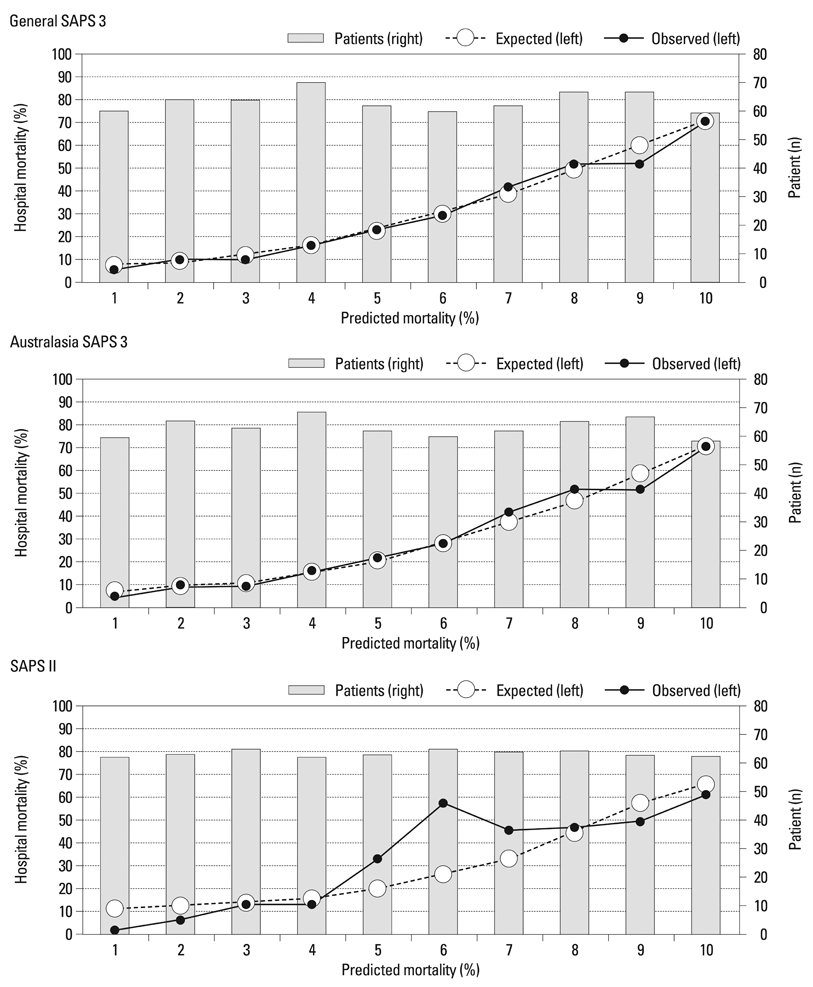Yonsei Med J.
2011 Jan;52(1):59-64. 10.3349/ymj.2011.52.1.59.
Validation of the Simplified Acute Physiology Score 3 Scoring System in a Korean Intensive Care Unit
- Affiliations
-
- 1Division of Pulmonary and Critical Care Medicine, Department of Medicine, Samsung Medical Center, Sungkyunkwan University School of Medicine, Seoul, Korea. suhgy@skku.edu
- 2Division of Pulmonary and Critical Care Medicine, Department of Medicine, Seoul Medical Center, Seoul, Korea.
- 3Department of Emergency Medicine, Pusan National University Yangsan Hospital, Pusan National University School of Medicine, Busan, Korea.
- KMID: 1106438
- DOI: http://doi.org/10.3349/ymj.2011.52.1.59
Abstract
- PURPOSE
The Simplified Acute Physiology Score (SAPS) 3 was recently proposed to reflect contemporary changes in intensive care practices. SAPS 3 features customized equations for the prediction of mortality in different geographic regions. However, the usefulness of SAPS 3 and its customized equation (Australasia SAPS 3) have never been externally validated in Korea. This study was designed to validate SAPS 3 and Australasia SAPS 3 for mortality prediction in Korea.
MATERIALS AND METHODS
A retrospective analysis of the prospective intensive care unit (ICU) registry was conducted in the medical ICU of Samsung Medical Center. Calibration and discrimination were determined by the Hosmer-Lemeshow test and area under the receiver operating characteristic (aROC) curve from 633 patients.
RESULTS
The mortalities (%) predicted by SAPS 3, Australasia SAPS 3, and SAPS II were 42 +/- 28, 39 +/- 27 and 37 +/- 31, respectively. The calibration of SAPS II was poor (p = 0.003). SAPS 3 and Australasia SAPS 3 were appropriate (p > 0.05). The discriminative power of all models yielded aROC values less than 0.8.
CONCLUSION
In Korea, mortality rates predicted using general SAPS 3 and Australasia SAPS 3 exhibited good calibration and modest discrimination. However, Australasia SAPS 3 did not improve the mortality prediction. To better predict mortality in Korean ICUs, a new equation may be needed specifically for Korea.
MeSH Terms
Figure
Cited by 1 articles
-
External Validation of the Acute Physiology and Chronic Health Evaluation II in Korean Intensive Care Units
Jae Yeol Kim, So Yeon Lim, Kyeongman Jeon, Younsuck Koh, Chae-Man Lim, Shin Ok Koh, Sungwon Na, Kyoung Min Lee, Byung Ho Lee, Jae-Young Kwon, Kook Hyun Lee, Seok-Hwa Yoon, Jisook Park, Gee Young Suh
Yonsei Med J. 2013;54(2):425-431. doi: 10.3349/ymj.2013.54.2.425.
Reference
-
1. Metnitz B, Schaden E, Moreno R, Le Gall JR, Bauer P, Metnitz PG. ASDI Study Group. Austrian validation and customization of the SAPS 3 Admission Score. Intensive Care Med. 2009. 35:616–622.
Article2. Knaus WA, Draper EA, Wagner DP, Zimmerman JE. APACHE II: a severity of disease classification system. Crit Care Med. 1985. 13:818–829.3. Knaus WA, Wagner DP, Draper EA, Zimmerman JE, Bergner M, Bastos PG, et al. The APACHE III prognostic system. Risk prediction of hospital mortality for critically ill hospitalized adults. Chest. 1991. 100:1619–1636.4. Le Gall JR, Lemeshow S, Saulnier F. A new Simplified Acute Physiology Score (SAPS II) based on a European/North American multicenter study. JAMA. 1993. 270:2957–2963.
Article5. Lemeshow S, Teres D, Klar J, Avrunin JS, Gehlbach SH, Rapoport J. Mortality Probability Models (MPM II) based on an international cohort of intensive care unit patients. JAMA. 1993. 270:2478–2486.
Article6. Groeger JS, Lemeshow S, Price K, Nierman DM, White P Jr, Klar J, et al. Multicenter outcome study of cancer patients admitted to the intensive care unit: a probability of mortality model. J Clin Oncol. 1998. 16:761–770.
Article7. Moreno RP, Metnitz PG, Almeida E, Jordan B, Bauer P, Campos RA, et al. SAPS 3--From evaluation of the patient to evaluation of the intensive care unit. Part 2: Development of a prognostic model for hospital mortality at ICU admission. Intensive Care Med. 2005. 31:1345–1355.
Article8. Soares M, Salluh JI. Validation of the SAPS 3 admission prognostic model in patients with cancer in need of intensive care. Intensive Care Med. 2006. 32:1839–1844.
Article9. Ledoux D, Canivet JL, Preiser JC, Lefrancq J, Damas P. SAPS 3 admission score: an external validation in a general intensive care population. Intensive Care Med. 2008. 34:1873–1877.
Article10. Metnitz PG, Valentin A, Vesely H, Alberti C, Lang T, Lenz K, et al. Prognostic performance and customization of the SAPS II: results of a multicenter Austrian study. Simplified Acute Physiology Score. Intensive Care Med. 1999. 25:192–197.
Article11. Metnitz PG, Moreno RP, Almeida E, Jordan B, Bauer P, Campos RA, et al. SAPS 3--From evaluation of the patient to evaluation of the intensive care unit. Part 1: Objectives, methods and cohort description. Intensive Care Med. 2005. 31:1336–1344.
Article12. Aggarwal AN, Sarkar P, Gupta D, Jindal SK. Performance of standard severity scoring systems for outcome prediction in patients admitted to a respiratory intensive care unit in North India. Respirology. 2006. 11:196–204.
Article13. Teres D, Lemeshow S. As American as apple pie and APACHE. Acute Physiology and Chronic Health Evaluation. Crit Care Med. 1998. 26:1297–1298.
- Full Text Links
- Actions
-
Cited
- CITED
-
- Close
- Share
- Similar articles
-
- A Clinical Analysis of Intensive Care Unit Admissions Using APACHE II Scoring System
- The Inter-Rater Reliability of Simplified Acute Physiology Score 3 (SAPS3) among Intensive Care Unit Nurses
- Validation of the APACHE IV model and its comparison with the APACHE II, SAPS 3, and Korean SAPS 3 models for the prediction of hospital mortality in a Korean surgical intensive care unit
- Performance of APACHE IV in Medical Intensive Care Unit Patients: Comparisons with APACHE II, SAPS 3, and MPMâ‚€ III
- Comparison of Predict Mortality Scoring Systems for Spontaneous Intracerebral Hemorrhage Patients


